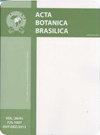Does the presence of exotic species decrease the initial development of native species in Brazilian seasonally dry tropical forests?
IF 1.1
4区 生物学
Q4 PLANT SCIENCES
引用次数: 0
Abstract
We assessed the impacts of the biological invasion of Azadirachta indica on the quality of plant species native to a Seasonally Dry Tropical Forest. We planted Amburana cearensis , Libidibia ferrea , Mimosa caesalpiniifolia , and Cenostigma pyramidale individuals alone and interacting with the exotic species. We measured their diameters at ground level and heights for four months, calculating their monthly and general average. After this period, seedlings were destroyed to obtain their number of leaves, leaf area, specific leaf area, length and primary root area, wood density, wood dry matter, leaf dry matter, shoot dry matter, primary root dry matter, secondary root dry matter, root system dry matter, and total dry matter. The presence of the exotic species affected the functional characteristics of native species in different ways. We observed negative effects in M. caesalpiniifolia and A. cearensis , positive effects in C. pyramidale , and mixed effects in L. ferrea . In addition, we identified conflicting demands between pairs of characteristics of the interacting species A. cearensis and M. caesalpiniifolia . Based on the results, it is possible to conclude that A. indica decreases the quality of individuals of most native species studied, which may have consequences for their establishment and the local biodiversity.外来物种的存在是否会减少巴西季节性干燥热带森林中本地物种的初始发育?
研究了印楝(Azadirachta indica)生物入侵对热带旱季森林原生植物质量的影响。我们单独种植Amburana cearensis、Libidibia ferrea、Mimosa caesalpiniifolia和Cenostigma pyramidale,并与外来种相互作用。我们测量了四个月的地面直径和高度,计算了它们的月平均和共同平均。在这段时间后,对幼苗进行灭苗,得到叶片数、叶面积、比叶面积、长度和初生根面积、木材密度、木材干物质、叶片干物质、地上部干物质、初生根干物质、次生根干物质、根系干物质和总干物质。外来种的存在以不同的方式影响着本地种的功能特征。结果表明,对该植物有负作用,对该植物有正作用,对该植物有混合作用。此外,我们还发现了相互作用物种A. cearensis和M. caesalpiniifolia的成对特征之间的冲突需求。结果表明,籼稻降低了大多数本地物种的个体质量,这可能对其建立和当地生物多样性造成影响。
本文章由计算机程序翻译,如有差异,请以英文原文为准。
求助全文
约1分钟内获得全文
求助全文
来源期刊

Acta Botanica Brasilica
PLANT SCIENCES-
CiteScore
2.30
自引率
9.10%
发文量
32
审稿时长
6-12 weeks
期刊介绍:
Experimental, theoretical and applied papers on all aspects of plant (including algae) and fungi biology are welcome. The submitted manuscript or its essential content must not have been published previously or be under consideration for publication elsewhere. Contributions should be substantial, written in high-quality English and show general interest. We expect that the submitted manuscript presents a great novelty in Botany, and this should attract a wide audience. Considering this, case studies are only considered if the narrative and implications are provided to be of general interest. Thus, manuscripts that report aspects of local interest are discouraged unless the implications of the findings are wide-reaching. Manuscripts with agronomic subjects are expected to contain a substantial amount of basic plant biology. Please see below some details for specific area.
 求助内容:
求助内容: 应助结果提醒方式:
应助结果提醒方式:


